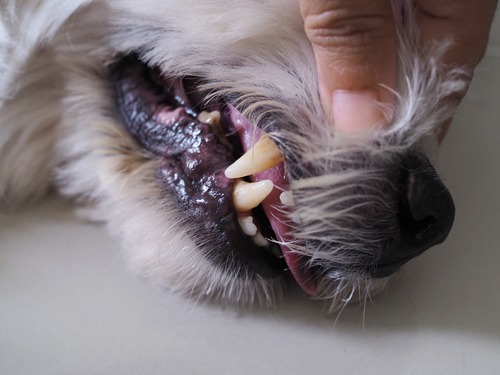When it comes to monitoring your dog’s health, one aspect that often goes unnoticed is the color of their gums. However, this small detail can be a significant indicator of your pet’s overall health. At Broomfield Veterinary Hospital in Broomfield, CO, we understand the importance of every aspect of your dog’s wellbeing. Pale gums in dogs can be a sign of various health issues, some of which require immediate attention. This article aims to educate dog owners about the causes of pale gums and the steps to take for their care. For personalized advice or concerns, we encourage you to call us at (303) 466-1764 or book an appointment online for a thorough checkup.
Understanding Pale Gums: What They Indicate in Your Dog’s Health
Pale gums in dogs are not a condition to take lightly. Typically, healthy gums should be a robust pink color, indicating good blood flow and oxygenation. When the gums turn pale, it’s often a sign that something is amiss. This can range from simple issues like dehydration to more serious conditions such as anemia, shock, or heart problems. If you notice a change in your dog’s gum color, it’s vital to observe them for other symptoms and consult with our veterinary professionals promptly.
The Role of Regular Check-Ups in Early Detection
Pet dental checks play a crucial role in early detection of health issues signified by pale gums. During a pet dental visit, our veterinarians can spot subtle changes that might not be immediately apparent to pet owners and recommend the next best steps to address your pet’s condition.
Common Causes of Pale Gums in Dogs
Several factors can lead to pale gums in dogs. Some of the common causes include:
- Anemia: This occurs when there’s a decrease in the number of red blood cells, affecting oxygen delivery throughout the body.
- Blood Loss: Severe blood loss due to injury or internal bleeding can lead to pale gums.
- Shock: Shock, often resulting from trauma, severe infection, or allergic reactions, can cause poor blood circulation, leading to pale gums.
- Heart Disease: Heart problems can affect blood circulation, making the gums appear pale.
Understanding these causes helps in identifying the need for a veterinary visit. It’s essential to watch for other symptoms such as lethargy, loss of appetite, or unusual behavior, and seek professional advice when in doubt.
Immediate Steps to Take When You Notice Pale Gums in Your Dog
Noticing pale gums in your dog can be unsettling, but taking appropriate and timely action is crucial. Here’s a detailed guide on what to do:
- Stay Calm and Assess the Situation: Your calmness is key in a potentially stressful situation for both you and your dog. Take a deep breath and try to assess your dog’s overall condition calmly.
- Check Gum Color Properly: To get a clear view of your dog’s gum color, ensure you’re in a well-lit area. Gently lift your dog’s lip and examine the gums. Healthy gums should be pink. If they are pale, white, or blue-tinged, it’s a cause for concern.
- Look for Additional Symptoms: Check for other signs that might accompany pale gums, such as fatigue, weakness, rapid breathing, a rapid heart rate, or a collapse. These symptoms, in conjunction with pale gums, could indicate anemia, shock, or other serious conditions.
- Comfort Your Dog: Keep your dog as comfortable and calm as possible. Avoid any unnecessary stress or excitement.
- Contact Your Veterinarian Immediately: If you observe pale gums, especially with other symptoms, it’s crucial to contact Broomfield Veterinary Hospital or your nearest veterinary clinic immediately. Explain the symptoms clearly over the phone so they can prepare for your arrival.
- Be Prepared to Provide Information: Once at the veterinary clinic, be ready to provide information about your dog’s recent behavior, diet, any incidents that could have led to injury, and any other symptoms you’ve observed. This information is vital for a quick and accurate diagnosis.
- Follow Veterinary Advice: Your veterinarian will likely perform a physical examination and possibly run diagnostic tests like blood work. It’s important to follow their advice and treatment plan closely.
- Monitor Your Dog Post-Veterinary Visit: After returning home, continue to monitor your dog closely. Watch for any changes in behavior or symptoms and keep a record of these observations. This record can be crucial for any follow-up visits to the vet.
- Ensure a Calm Recovery Environment: Create a quiet, comfortable space for your dog to recover. Avoid loud noises or disturbances and follow any dietary recommendations given by the vet.
Remember, pale gums can indicate a range of health issues, some of which may be serious. Quick action and professional veterinary care are essential for the health and well-being of your dog.
Preventive Care and Regular Check-Ups
Prevention is always better than cure. Pet wellness checks are vital for detecting conditions that might cause pale gums early. These check-ups also offer an opportunity to discuss preventive care measures like proper nutrition, regular exercise, and routine blood tests. A balanced diet and regular exercise also play a significant role in maintaining your dog’s overall health and can prevent conditions that lead to pale gums.
How Broomfield Veterinary Hospital Can Help
At Broomfield Veterinary Hospital, we are committed to the health and well-being of your canine companion. Our team of experienced veterinarians is equipped to diagnose and treat various conditions that could cause pale gums in dogs. We offer comprehensive services from routine check-ups to advanced medical care. If you have any concerns about your dog’s gum color or their overall health, schedule an appointment online now.
Prioritizing Your Dog’s Health
Understanding the causes and implications of pale gums in dogs is an important aspect of responsible pet ownership. By staying informed and vigilant, you can ensure the best care for your furry family member. For any concerns, schedule an appointment online or call Broomfield Veterinary Hospital. We’re here to support you every step of the way in ensuring a healthy, happy life for your dog.





